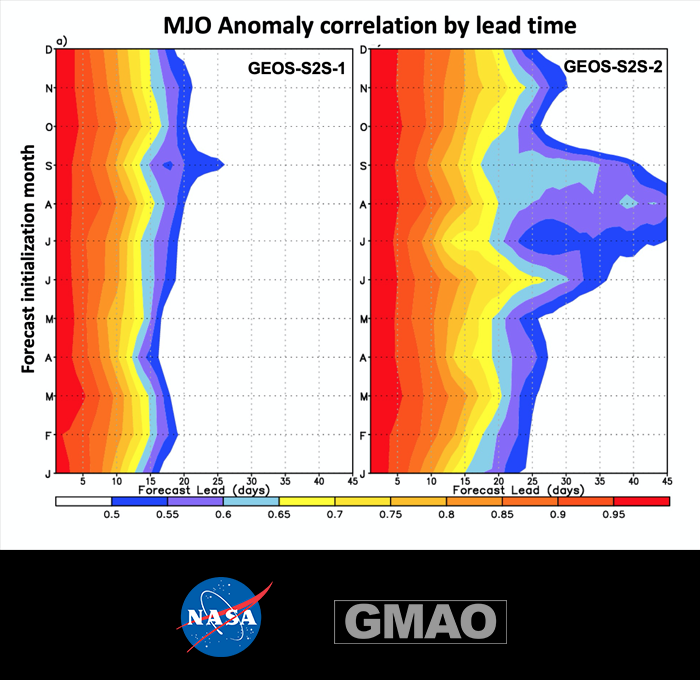Major Advance in MJO Prediction Skill in GMAO’s Near Real Time Seasonal Forecasts
Version 2 of the GMAO's seasonal prediction system, GEOS-S2S-2, has been running in near-real-time since November 2018. The system is described in detail by Molod et al. (2020) and includes some substantial advances over Version 1 of GEOS-S2S (Borovikov et al., 2019). GEOS-S2S-2 includes a coupled atmosphere-ocean-sea ice model, an ocean data assimilation that is forced in part by atmospheric analyses from MERRA-2, and an ensemble perturbation strategy to generate initial conditions for seasonal (nine-month) and subseasonal (45-day) forecasts. This is the first GEOS-S2S system that has focused explicitly on producing the subseasonal forecasts, which are provided to the NOAA SubX project. Seasonal forecasts continue to be provided to the National Multi-Model Ensemble (NMME) project, as well as to other users.
The Madden Julian Oscillation (MJO) is the dominant mode of tropical subseasonal variability that has major impacts on regional precipitation patterns as it propagates around the globe, as well as impacting through teleconnections the development of extratropical weather systems (e.g., Waliser et al., 2003). The prediction skill at subseasonal timescales is thus strongly controlled by the ability of the prediction model to represent the MJO. Among many other advances in Version 2 of GEOS-S2S, the forecasts demonstrate a substantial improvement in representing the MJO, as illustrated by the Real-time Multivariate MJO (RMM) index, which has become a standard metric of model performance. The RMM is based on the zonal wind at 850 and 200 hPa and the outgoing longwave radiation, following the method described in Wheeler and Hendon (2004) and Gottschalck et al. (2010).

The Madden-Julian Oscillation (MJO) is predicted much more realistically in version 2 of the NASA GEOS-S2S system (GEOS-S2S-2) than in the older version (GEOS-S2S-1). The anomaly correlation from the widely used Realtime Multivariate MJO (RMM) index illustrates an increase of skill by about five days throughout the year (the yellow 0.65 correlation contour advances from about 13 to 18 days) and that there is a prominent improvement in the second half of the year, with correlations of up to 0.6 extending beyond 30 days in August and September in GEOS-S2S-2.
The comparison shows that at short lead times (1- to 10-day lead), the correlation is greater than 0.80–0.85 for all initial condition months for both GEOS-S2S-2 and GEOS-S2S-1. At intermediate leads, up to 25 days, there is a clear improvement in skill in GEOS-S2S-2 relative to GEOS-S2S-1. Prediction skill at long lead times is particularly high in GEOS-S2S-2 for summer initial conditions, exceeding correlations of 0.5 even at 40-day lead. Note that, when compared with current S2S forecasts from other centers (e.g., Saha, 2014; Scaife et al., 2016), GEOS-S2S-2 is among the systems with the highest prediction skill for the MJO.

Eastward propagation of the MJO revealed by MERRA-2 and GEOS-S2S-2
Figure 2 shows an eastward propagation of the MJO revealed by MERRA-2 and GEOS-S2S-2. It is evident that the GEOS-S2S-2 reproduces quite realistically the observed MJO propagating eastward along the equator from Africa/western Indian Ocean to the eastern Pacific. Particularly, the predicted MJO anomaly shows a good agreement with the observed anomaly even at forecast lead beyond 30 days in the eastern Pacific (150°-120°W).
A recent NASA Center for Climate Simulation (NCCS) news highlight article described some computational aspects of the GEOS-S2S system and showed some results of forecasts (https://www.nccs.nasa.gov/news-events/nccs-highlights/prediction-system).
References:
Borovikov, A. Y., R. I. Cullather, et al., 2019: GEOS-5 seasonal forecast system. Clim. Dyn, 53, 7335-7361. doi: 10.1007/s00382-017-3835-2.
Gottschalck, J., M. Wheeler, et al., 2010: A Framework for Assessing Operational Madden–Julian Oscillation Forecasts. Bull. Amer. Meteor. Soc., 91, 1247-1258, doi: 10.1175/2010BAMS2816.1.
Molod, A., E. Hackert, et al., 2020: GEOS-S2S Version 2: The GMAO High Resolution Coupled Model and Assimilation System for Seasonal Prediction. J. Geophy. Res.- Atmos., 125, e2019JD031767. doi: 10.1029/2019JD031767.
Saha, S., 2014: The NCEP climate forecast system version 2. Journal Climate, 27, 2185-2208. doi: /10.1175/JCLI-D-12-00823.1.
Scaife, A. A., A. Yu. Karpechko, et al., 2016: Seasonal winter forecasts and the stratosphere. Atmos. Sci. Lett., 17(1), 51-56. doi: 10.1002/asl.598.
Waliser, D. E., K. M. Lau, W. Stern and C. Jones, 2003: Potential predictability of the Madden‐Julian Oscillation. Bull. Amer. Meteor. Soc., 84, 33-50, doi:10.1175/BAMS-84-1-33.
Wheeler, M. C. and H. H. Hendon, 2004: An All-Season Real-Time Multivariate MJO Index: Development of an Index for Monitoring and Prediction. Mon. Wea. Rev., 132, 1917-1932, doi:10.1175/1520-0493(2004)132<1917:AARMMI>2.0.CO;2.

